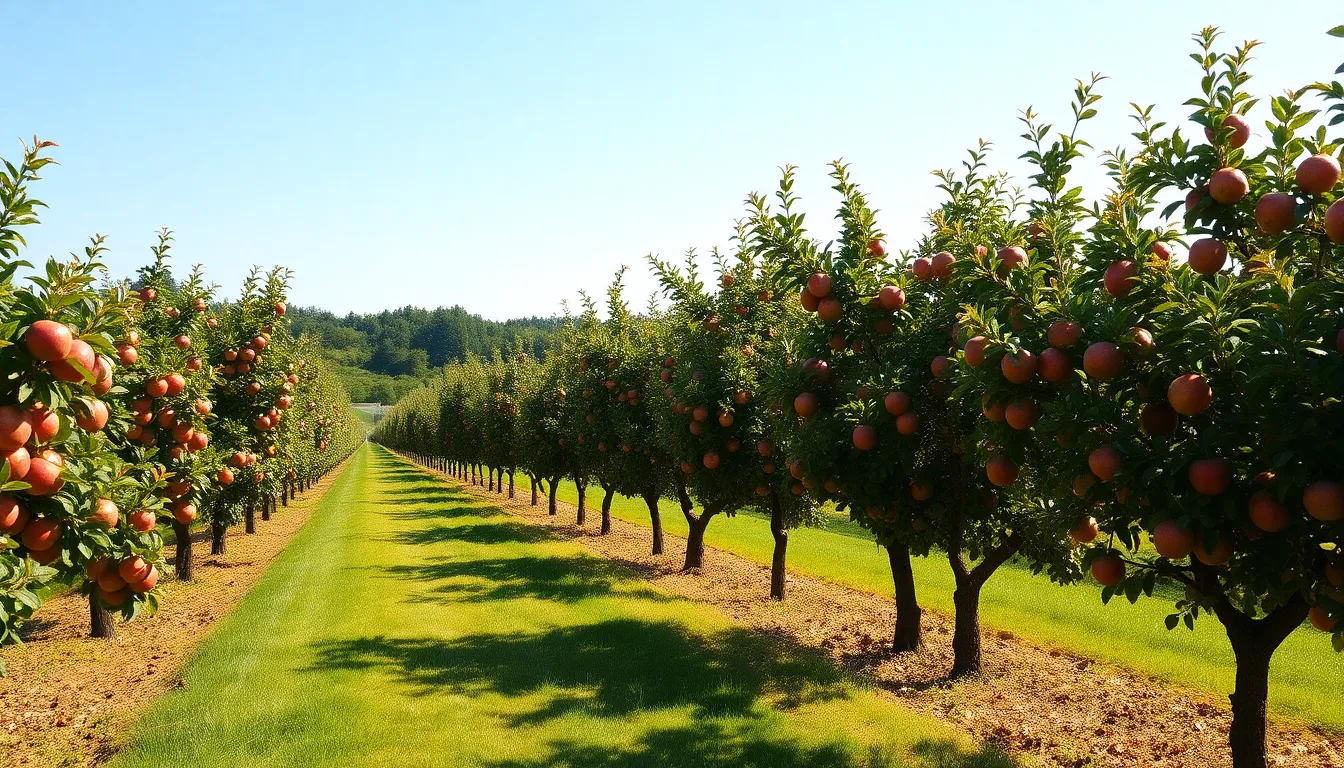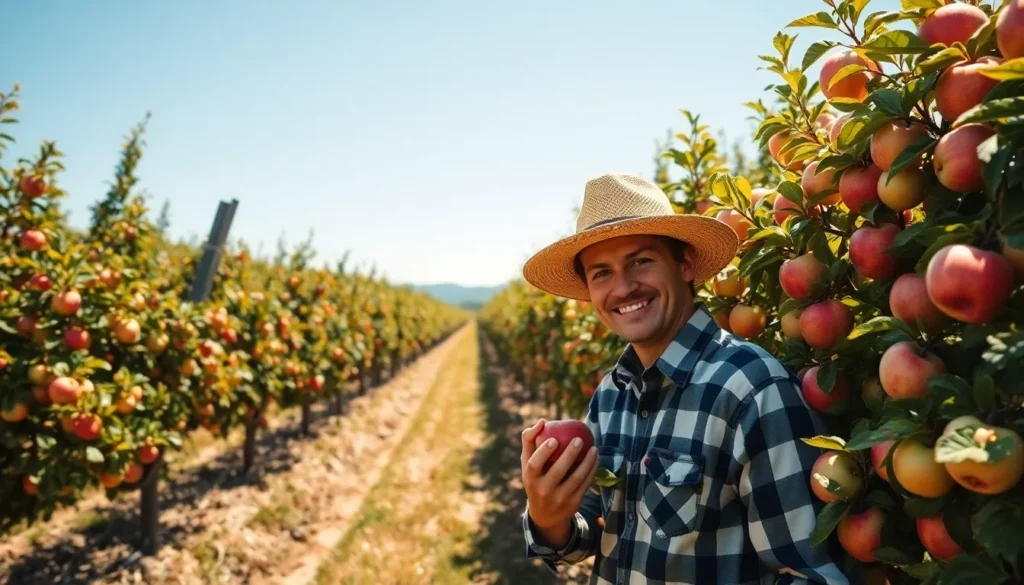Table of Contents
ToggleApples have a way of making their way into our lives, whether it’s in a pie, a crisp, or just a good ol’ snack. But have you ever wondered where these juicy wonders actually hail from? Spoiler alert: it’s not just the grocery store! The story of apples is a juicy tale that stretches back thousands of years and spans continents.
Overview of Apple Origin
Apples are native to Central Asia, specifically in the region encompassing Kazakhstan, Kyrgyzstan, and China. The wild ancestor of the modern apple, Malus sieversii, thrives in these areas, showcasing the species’ adaptability and diversity. Over time, humans domesticated apples, spreading them across continents through trade routes.
Europe saw apples grow in popularity through the Roman Empire’s expansion. Romans cultivated various apple varieties, introducing them to new regions. By the Middle Ages, apples became staples in European diets, leading to further development of cultivars.
In North America, apples arrived with European settlers in the 17th century. Early colonists planted orchards, ensuring apple varieties adapted to local climates. Today, the United States ranks as one of the world’s largest apple producers, with Washington, New York, and Michigan leading in cultivation.
Modern breeding techniques allow for the development of diverse apple types. Popular varieties, such as Fuji and Granny Smith, emerged from a rich historical lineage. These varieties showcase unique flavors, textures, and uses, catering to a wide range of preferences.
Climate plays a significant role in apple cultivation. Apples thrive in temperate climates with distinct seasonal changes, ensuring proper fruit developing conditions. Regions with cold winters and mild summers provide the ideal environment for apple trees.
The journey of apples from their origins to widespread availability highlights their significance in global agriculture. As apples continue to adapt and evolve, they remain a vital component in diets and cultures around the world.
Historical Context

The history of apples reveals their deep-rooted connections to human civilizations. Apples originated in Central Asia, with their wild ancestor, Malus sieversii, thriving in Kazakhstan and Kyrgyzstan.
Early Cultivation
Cultivation began approximately 4,000 years ago in Asia. Ancient cultures recognized the apple’s value, utilizing it for food and trade. Records indicate that Mesopotamians cultivated apples, incorporating them into their diets. Traditional methods of cultivation involved grafting, leading to diverse apple varieties. By the time of the Roman Empire, apples grew widely across Europe due to their adaptability.
Spread of Apples Worldwide
Trade routes facilitated the spread of apples across continents. European settlers introduced apple trees to North America in the 17th century. These settlers planted orchards that flourished in various climates, leading to local cultivation. Specialized varieties developed, suited to different regions. Over time, apple cultivation became integral to agricultural practices worldwide. Today, apples grow in numerous countries, establishing them as a staple fruit globally.
Geographic Regions of Origin
Apples trace their roots to several geographic regions, primarily in Central Asia.
Central Asia
Central Asia serves as the original homeland for apples, particularly in Kazakhstan, Kyrgyzstan, and parts of China. Malus sieversii, the wild ancestor of cultivated apples, flourishes in these areas. Genetic studies confirm that this region holds significant diversity in apple species. Cultivation began around 4,000 years ago, primarily driven by early agricultural societies. Historical records show that these cultures recognized apples as a staple food source. Over time, traders and explorers introduced varieties from Central Asia to other parts of the world.
Cultural Significance
Cultural significance of apples extends beyond geography. In ancient Mesopotamia, apples represented prosperity and were highly valued in trade. Various civilizations incorporated apples into myths, art, and daily life, symbolizing health and longevity. Romans played an essential role in spreading apple varieties throughout Europe, enhancing their cultural relevance. By the Middle Ages, apples became integral to European cuisine and agricultural practices. Modern society continues to celebrate apples, recognizing their importance in various culinary traditions. Festivals dedicated to apples highlight their enduring value and cultural connection.
Types of Native Apples
Apples encompass a variety of types, with two significant species associated with their native origins.
Malus domestica
Malus domestica, commonly known as the cultivated apple, dominates apple varieties globally. They originate from ancient hybrids and cultivation practices carried out by early agricultural societies. Over time, people selectively bred Malus domestica for desirable traits such as sweetness, crispness, and storage longevity. This variety contributes to about 90% of all apple production today. Popular cultivars include Gala, Honeycrisp, and Braeburn, each offering unique flavors and textures suitable for fresh consumption or culinary applications. Cultivation practices have adapted throughout centuries, increasing resilience against diseases and pests.
Malus sieversii
Malus sieversii serves as the wild ancestor of the modern apple, thriving primarily in Central Asia. This species showcases remarkable genetic diversity, creating the foundation for many cultivated varieties. Researchers pinpoint Kazakhstan as its native region, where Malus sieversii grows in mountainous areas, often in wild forests. The fruit displays a range of colors and flavors, sometimes varying within one tree. Genetic studies reveal that breeding with Malus sieversii enhances qualities in cultivated apples, such as disease resistance. The significance of Malus sieversii extends beyond its genetic contributions, playing a critical role in apple history and agricultural practices worldwide.
Apples have a rich history that spans thousands of years and continents. Their journey from wild origins in Central Asia to becoming a staple in diets worldwide showcases their adaptability and significance. The diverse cultivation practices and selective breeding have led to a multitude of varieties, each with unique flavors and uses.
As apples continue to thrive in various climates and cultures, they remain a symbol of health and prosperity. Their enduring presence in culinary traditions and agricultural practices highlights the importance of preserving their genetic diversity for future generations. The story of apples is far more than just a fruit; it’s a testament to human ingenuity and connection to nature.







